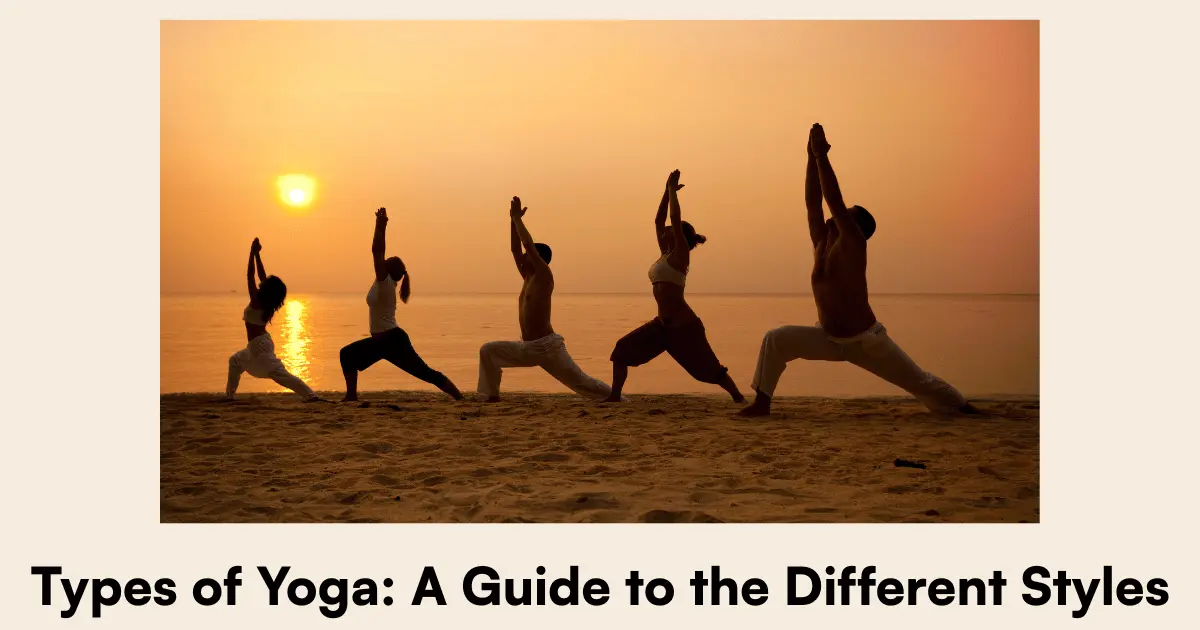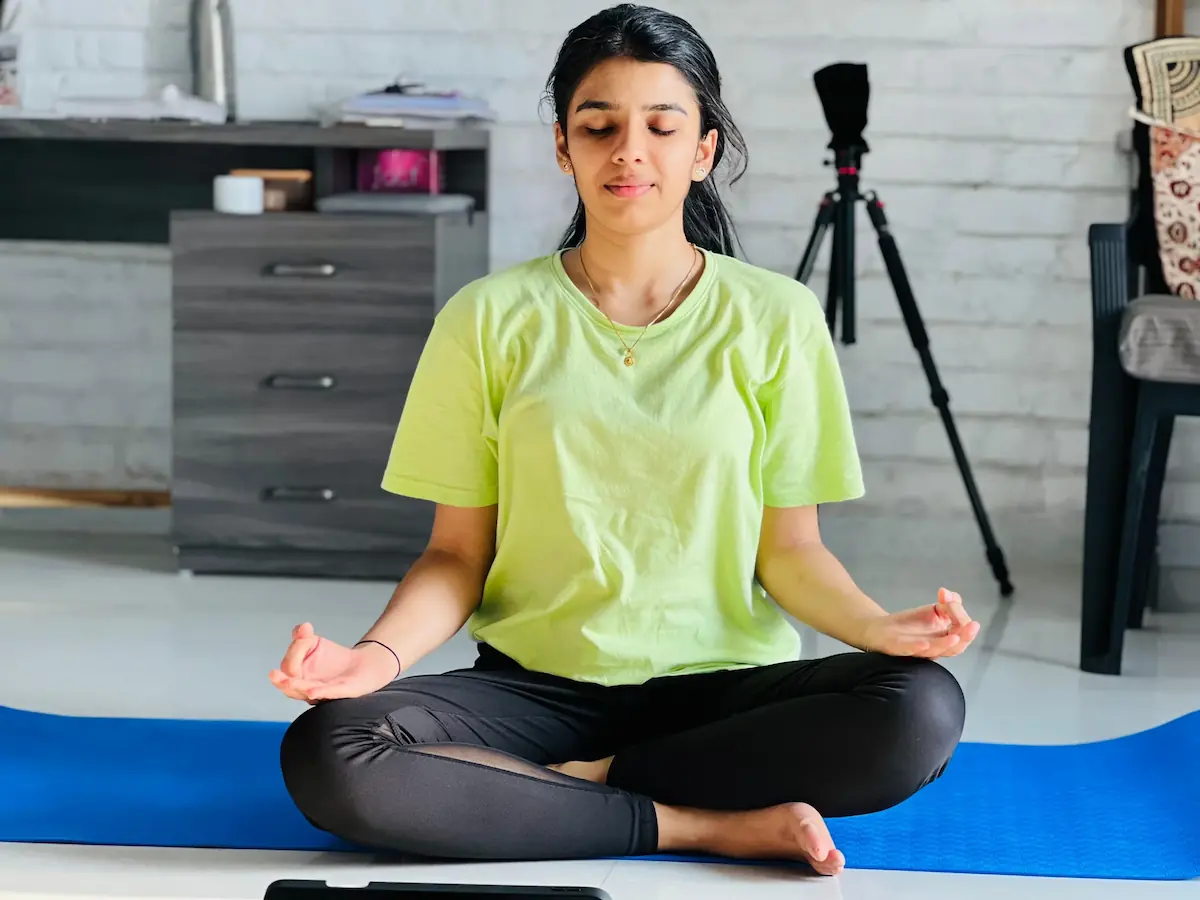With so many types of yoga to choose from, finding the right one can feel like picking a favorite song—exciting but a bit daunting. Whether you want a sweaty workout, a deep stretch, or a calm escape, there’s a yoga style that’s perfect for you.
This guide explores nine popular yoga styles—Hatha, Vinyasa, Ashtanga, Iyengar, Kundalini, Bikram, Restorative, Yin, and Prenatal—to help you find the best yoga for you. We’ll dive into what makes each unique, who they suit, and how to start, so you can pick a practice that fits your life. Ready to roll out your mat? Let’s find your flow!
New to yoga? Start with our Essential Yoga Poses for Beginners.
The Roots of Yoga Styles
Yoga began over 5,000 years ago in India, blending movement, breath, and meditation to balance body and mind. Ancient texts like the Yoga Sutras set the stage, and by the 20th century, teachers like Krishnamacharya shaped modern yoga styles. For example, his work led to Ashtanga’s intensity and Iyengar’s precision. Why care about history? Because it shows how each style offers a unique path to wellness. Want more backstory? Check out What Is Yoga?.
Why Try Different Yoga Styles?
Each yoga style has its own flavor—some energize, others soothe. For instance, Vinyasa flows like a dance, while Restorative feels like a nap. Exploring types of yoga helps you match your practice to your goals—strength, calm, or flexibility. Plus, mixing styles keeps it fun! A 2023 Yoga Alliance survey found 70% of yogis try multiple styles for variety. So, let’s unpack nine options to find the best yoga for me.

Hatha Yoga: The Gentle Start
What Is Hatha Yoga?
Hatha is the foundation of many yoga styles, focusing on poses (asanas), breathing (pranayama), and mindfulness. It’s slow, holding poses like Mountain or Warrior I for 5–10 breaths, perfect for learning basics.
Key Features
- Pace: Easygoing—1–2 poses per minute.
- Focus: Alignment, breath, balance.
- Setting: 45–60-minute classes, often quiet studios or home.
Benefits
- Improves posture (20% better in 8 weeks, per a 2019 Journal of Physical Therapy study).
- Reduces stress with steady breaths—lowers cortisol.
- Builds flexibility gently—great for tight shoulders.
Who’s It For?
Hatha’s the best yoga for me if you’re new, want calm, or need a low-impact stretch. It suits all ages, from teens to seniors. Too slow? It’s still a great base.
How to Start
- Poses: Try Child’s Pose or Downward Dog—see Essential Yoga Poses for Beginners.
- Classes: Look for “Hatha Basics” on apps like Glo or local studios.
- Tips: Use a block for alignment—avoid slouching with Common Mistakes Beginners Make in Yoga.
Vinyasa Yoga: Move with Breath
What Is Vinyasa Yoga?
Vinyasa links breath to movement in a flowing type of yoga. Picture shifting from Plank to Cobra to Downward Dog, each move tied to an inhale or exhale. It’s creative—sequences change every class.
Key Features
- Pace: Moderate to fast—3–5 poses per minute.
- Focus: Fluidity, energy, breath sync.
- Setting: 60–75-minute classes, often with music like lo-fi.
Benefits
- Burns 300–500 calories per hour (Medicine & Science in Sports, 2022).
- Boosts focus through rhythmic flow.
- Strengthens arms and core—think Chaturanga.
Who’s It For?
Love music and motion? Vinyasa’s your vibe. It’s good for beginners with tweaks or active folks wanting a workout. Busy mind? The flow keeps you present.
How to Start
- Poses: Practice Sun Salutations—Plank, Upward Dog.
- Classes: Try “Vinyasa Flow” on YouTube (Yoga with Adriene).
- Tips: Watch wrist alignment—check Common Mistakes Beginners Make in Yoga.
Ashtanga Yoga: Power and Routine
What Is Ashtanga Yoga?
Ashtanga is a high-energy yoga style with a set sequence—90+ poses like Sun Salutations and twists. You move fast, jumping between poses with Ujjayi breath (soft hiss). It’s tough but builds strength.
Key Features
- Pace: Fast—5–8 poses per minute.
- Focus: Discipline, stamina, structure.
- Setting: 75–120-minute “Mysore” or led classes.
Benefits
- Gains 30% muscle strength in 6 months (Sports Medicine, 2021).
- Sharpens focus with repetition.
- Raises heart rate—cardio boost.
Who’s It For?
Ashtanga fits routine lovers with energy to spare. Beginners need guidance—Hatha first—but it’s great for goal-driven folks.
How to Start
- Poses: Learn Sun Salutation A—Chaturanga, Upward Dog.
- Classes: Find “Led Ashtanga” at studios.
- Tips: Don’t overjump—see Common Mistakes Beginners Make in Yoga.
Iyengar Yoga: Precision and Props
What Is Iyengar Yoga?
Iyengar, created by B.K.S. Iyengar, obsesses over yoga alignment. Poses are held long (30–60 seconds), using props like blocks, straps, or walls to perfect form. It’s methodical, not rushed.
Key Features
- Pace: Slow—1 pose per minute.
- Focus: Precision, posture, stability.
- Setting: 60–90-minute classes, prop-heavy studios.
Benefits
- Fixes posture—50% less back pain in 12 weeks (Pain Medicine, 2020).
- Enhances joint stability—great for injury recovery.
- Teaches body awareness through detail.
Who’s It For?
Iyengar’s the best yoga for me if you love detail, have injuries, or want perfect form. Beginners welcome—props make it accessible—but it’s less flowy.
How to Start
- Poses: Try Warrior II with a block under the hand.
- Classes: Seek “Iyengar Level 1” at certified studios.
- Tips: Props are key—set up with How to Start a Yoga Practice at Home.
Kundalini Yoga: Energy and Spirit
What Is Kundalini Yoga?
Kundalini blends poses, chanting, meditation, and breathwork to awaken “kundalini” energy at your spine’s base. Expect dynamic moves (e.g., spinal twists), mantras, and breathing like Breath of Fire.
Key Features
- Pace: Mixed—quick bursts, long meditations.
- Focus: Energy, mindfulness, spirituality.
- Setting: 60–90-minute classes, often with chanting.
Benefits
- Reduces anxiety—30% calmer in 8 weeks (Journal of Alternative Medicine, 2021).
- Boosts lung capacity with breathwork.
- Feels uplifting—mantras spark joy.
Who’s It For?
Kundalini suits spiritual seekers or those craving variety. Beginners can try it, but the chanting might feel new. Want a mood lift? This is it.
How to Start
- Poses: Practice Cat-Cow with Breath of Fire.
- Classes: Find “Kundalini Yoga” on apps like Insight Timer.
- Tips: Open mind—chanting’s optional at first.
Bikram Yoga: Heat and Sweat
What Is Bikram Yoga?
Bikram, or “hot yoga,” involves 26 poses in a 105°F room with 40% humidity. You repeat the same sequence—Standing Bow, Triangle—for 90 minutes, sweating buckets.
Key Features
- Pace: Moderate—2 sets per pose.
- Focus: Endurance, detox, flexibility.
- Setting: Hot studios, 90-minute classes.
Benefits
- Burns 400–600 calories per session (Journal of Strength & Conditioning, 2018).
- Loosens tight muscles with heat.
- Builds mental grit—heat’s intense.
Who’s It For?
Bikram’s for sweat lovers or flexibility seekers. Beginners can try but hydrate well—heat’s no joke. Not for pregnancy or heart issues.
How to Start
- Poses: Try Tree Pose—hydrate first.
- Classes: Look for “Bikram” or “Hot Yoga” studios.
- Tips: Bring a towel, water, and patience.
Restorative Yoga: Total Relaxation
What Is Restorative Yoga?
Restorative yoga is like a cozy nap—poses like Supported Child’s Pose are held 5–20 minutes with props (bolsters, blankets). It’s about total relaxation, not stretching hard.
Key Features
- Pace: Ultra-slow—3–5 poses per class.
- Focus: Rest, stress relief, healing.
- Setting: 60–75-minute classes, candlelit vibes.
Benefits
- Cuts stress—40% lower cortisol in 10 weeks (Psychoneuroendocrinology, 2019).
- Eases chronic tension—great for insomnia.
- Supports recovery—post-injury or burnout.
Who’s It For?
Restorative’s the best yoga for me if you’re exhausted, stressed, or healing. Beginners love its ease—no strength needed.
How to Start
- Poses: Try Legs-Up-the-Wall with a blanket.
- Classes: Seek “Restorative Yoga” at studios or online.
- Tips: Props matter—see How to Start a Yoga Practice at Home.
Yin Yoga: Deep and Quiet
What Is Yin Yoga?
Yin holds poses like Pigeon for 3–5 minutes to stretch deep tissues (ligaments, fascia). It’s calm, meditative, often with soft music, focusing on joint health over muscle work.
Key Features
- Pace: Very slow—3–6 poses per class.
- Focus: Flexibility, calm, joints.
- Setting: 60–90-minute classes, cozy studios.
Benefits
- Gains 40% hip flexibility in 12 weeks (Yoga Journal, 2020).
- Soothes anxiety—meditative vibe.
- Balances high-energy days.
Who’s It For?
Yin suits stiff or stressed folks. It’s beginner-friendly—no power needed—but athletes love it for recovery.
How to Start
- Poses: Try Butterfly—use props for comfort.
- Classes: Find “Yin Yoga” on apps like Gaia.
- Tips: Stay patient—long holds teach calm.
Prenatal Yoga: Support for Pregnancy
What Is Prenatal Yoga?
Prenatal yoga tailors poses for pregnant bodies, using gentle stretches like Cat-Cow to ease discomfort. It includes breathing and pelvic exercises for labor prep.
Key Features
- Pace: Slow—1–2 poses per minute.
- Focus: Comfort, strength, labor prep.
- Setting: 45–60-minute classes, often with moms-to-be.
Benefits
- Reduces back pain—60% less in 8 weeks (Obstetrics & Gynecology, 2021).
- Preps pelvis for delivery.
- Builds community—mom bonding.
Who’s It For?
Prenatal’s the best yoga for me if you’re expecting. Safe for beginners—always check with your doctor. Not pregnant? Skip this one.
How to Start
- Poses: Try Modified Warrior—avoid lying flat.
- Classes: Look for “Prenatal Yoga” at studios or online.
- Tips: Use props—set up at home.
Comparing Yoga Styles: At a Glance
| Style | Pace | Focus | Best For | Calories/Hour |
|---|---|---|---|---|
| Hatha | Slow | Basics, breath | Beginners, calm seekers | 150–250 |
| Vinyasa | Moderate-Fast | Flow, energy | Active folks | 300–500 |
| Ashtanga | Fast | Strength, routine | Goal-driven | 400–600 |
| Iyengar | Slow | Precision, posture | Injury recovery | 150–250 |
| Kundalini | Mixed | Energy, spirit | Spiritual seekers | 200–350 |
| Bikram | Moderate | Endurance, heat | Sweat lovers | 400–600 |
| Restorative | Ultra-Slow | Rest, healing | Stressed, tired | 100–200 |
| Yin | Very Slow | Deep stretch, calm | Stiff folks | 100–200 |
| Prenatal | Slow | Comfort, pregnancy | Expecting moms | 150–250 |
How to Pick Your Yoga Style
Choosing the best yoga for me depends on you:
- Newbie? Start with Hatha or Restorative—easy entry.
- Stressed? Try Yin or Restorative—pure calm.
- Active? Vinyasa, Ashtanga, or Bikram bring sweat.
- Pregnant? Prenatal’s tailored for you.
- Injured? Iyengar’s props support healing.
More tips:
- Sample It: Apps like Down Dog offer free trials.
- Talk to Teachers: Studios guide you—try a mixed class.
- Track Mood: Post-class, note: Energized? Relaxed? That’s your style.
Need basics? Visit our Ultimate Guide to Yoga Basics.
FAQs About Yoga Styles
Which Style Suits Beginners?
Hatha and Restorative are easiest—slow, and supportive. Yin’s great too if you like calm.
Can I Blend Styles?
Absolutely! For example, try Vinyasa mornings, Restorative nights—60% of yogis mix it up (Yoga Journal, 2022).
How Long Are Classes?
Hatha, Prenatal: 45–60 min; Vinyasa, Kundalini, Restorative, Yin: 60–90 min; Ashtanga, Bikram, Iyengar: 75–120 min.
What Gear Do I Need?
A mat for most; props for Iyengar, Restorative, Yin—check How to Start a Yoga Practice at Home.
Conclusion
From Hatha’s gentle start to Bikram’s heat, yoga styles like Vinyasa, Ashtanga, Iyengar, Kundalini, Restorative, Yin, and Prenatal offer a practice for every goal.
Finding the best yoga for me means exploring these types of yoga—whether you want strength, peace, or support. So, try one this week! Flow with Vinyasa, relax with Yin, or prep with Prenatal. Your mat’s ready—what’s your pick? Share below or learn more at What Is Yoga?.


2 thoughts on “Yoga Styles: Your Guide to Finding the Perfect Practice”